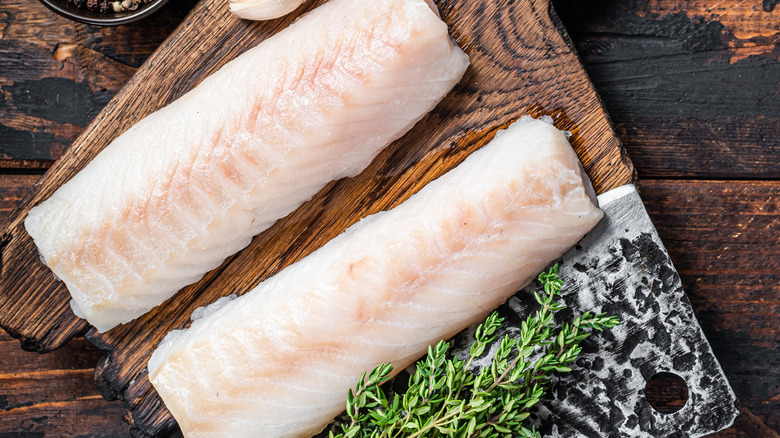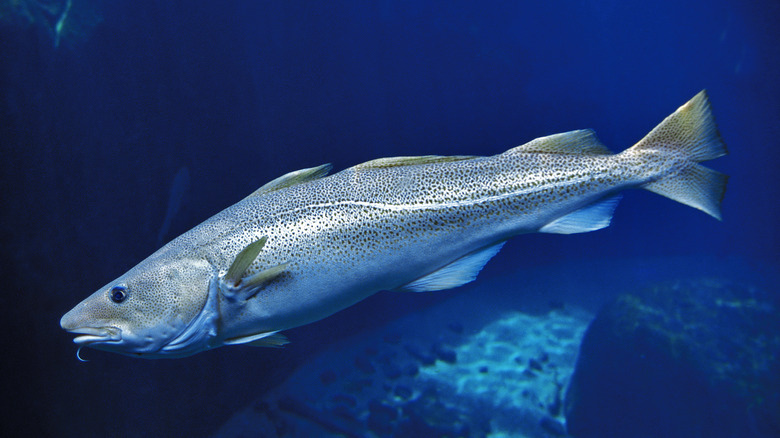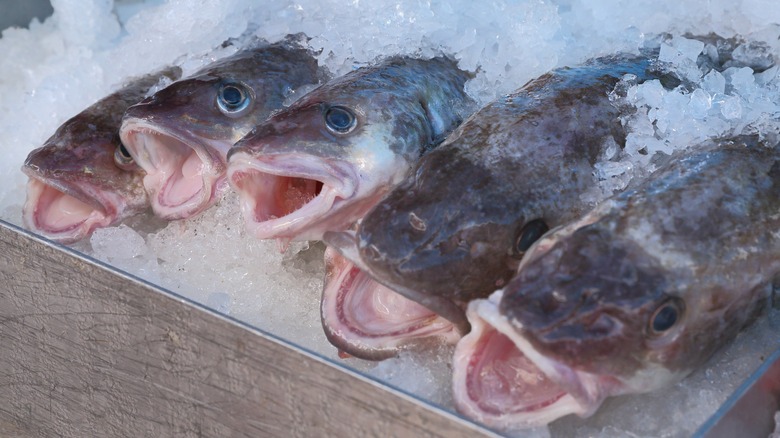The 2 Most Common Varieties Of Cod, Explained
Hanging up above the House of Representatives in the Massachusetts State House on Beacon Hill is The Sacred Cod. This enormous, wooden sculpture of the Atlantic cod, after which another iconic Massachusetts location — Cape Cod — is named, hangs as a representation of the Commonwealth's strong fishing heritage (via Atlas Obscura and Cape Cod Explore).
The current Sacred Cod was carved out of pine in 1784. It's five feet long and weighs a considerable amount, as one would-be thief discovered to his detriment in the 1960s. Still, the sculpture goes to show just how much impact a natural resource can have on the history of a community.
The Sacred Cod speaks to something else as well. Cod has been, throughout history, a popular fish across the world. There are excellent stocks of multiple varieties in both the Atlantic and Pacific oceans. Salt cod is a staple of many European, Caribbean, and American nations, per The Spruce Eats. Portugal, for instance, has such a love for salt cod (bacalhau) that it has become part of the national identity, per Now in Portugal.
Cod, broadly speaking, is a type of white fish in the same family as pollock and haddock. Its firm flesh makes it suitable for virtually all types of cooking, be it grilling, steaming, or frying. The two most common varieties, Atlantic and Pacific cod, are as similar as they are different, as we'll explain.
The Atlantic cod
As one would surmise, the biggest difference between the two cods is the oceans in which they live. Atlantic cod is found exclusively in the northern half of the Atlantic ocean. The MarineBio Conservation Society explains that the range of the Atlantic cod stretches from Greenland to North Carolina, the coast of Iceland, Arcto-Norwegian waters, and the Bay of Biscay off the coasts of France and Spain.
Their U.S. habitat stretches along the East Coast from the Gulf of Maine to Cape Hatteras, North Carolina. According to the NOAA Fisheries, Atlantic cod can grow as large as 51 inches (4.25 feet) and weigh up to 77 pounds, and are on watch due to drastically reduced numbers. So, a sizable, but not enormous, fish.
As for taste, the Atlantic cod is on the sweeter side, with a semi-firm meat that flakes and falls apart easily when cooked (via Pittmans Seafoods). You'll be hard-pressed to find a whole cod for sale at your local market, however. According to The Spruce Eats, cod is typically sold as prepared filets, making it incredibly easy to cook at home across a variety of different cooking methods.
One of the most traditional methods of preparing cod is to fry it, as you would for classic fish 'n chips. The cod, or haddock if cod isn't available, gets covered in a hearty batter of beer, flour, and salt, and fried until light and crispy.
The Pacific cod
While Atlantic cod are on watch due to being over fished, the Pacific cod is considered a smarter seafood choice owing to sustainability measures brought on by U.S. regulations, per NOAA Fisheries. The four stocks of Pacific cod are the Bering Sea, Aleutian Islands, the Gulf of Alaska, and the Pacific Coast.
In the western Pacific, this cod can be found in the Sea of Japan and the Yellow Sea off the coast of China, per NOAA and Fish Base. These fish can live up to 20 years and grow to be 6 feet long, nearly two feet longer than the Atlantic cod.
On the taste front, Pittmans Seafoods describes the Pacific cod as milder and more savory than its Atlantic companion, with firmer flesh that yields chunkier flakes. Pacific cod, with its savory taste and firm texture, may yield well to baking or grilling.
As with anything, the cod you choose to eat for dinner is down to geography and the flavor preferences of whoever is eating. All differences aside, whichever cod you choose, you've got yourself a flavorful fish that's been popular for centuries and looks like it will remain so for centuries to come.


